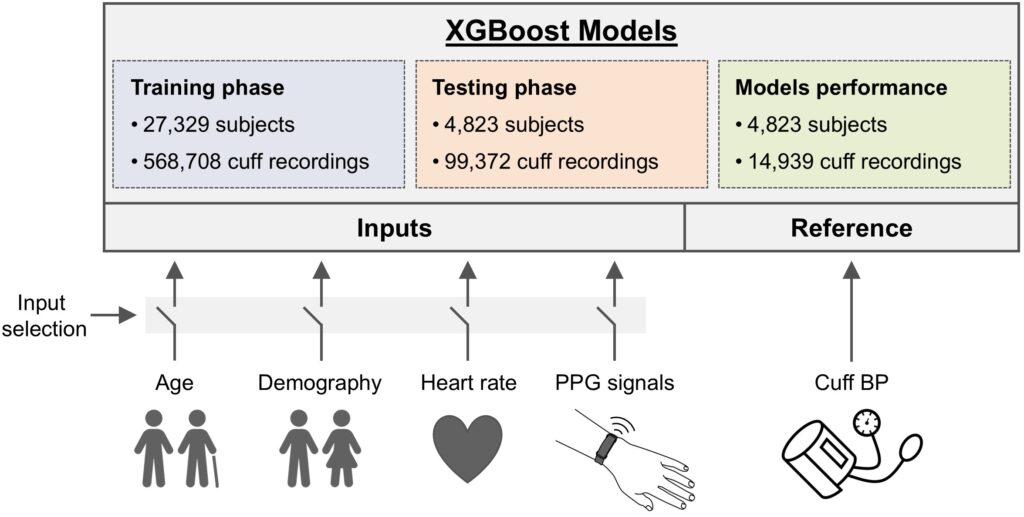Slip the band on your wrist and leave it there. Then, while you’re wearing the band, it automatically pulses green light from two LEDs into the skin and in-built optical sensors record the reflected waveform. A bespoke cloud‑based algorithm then converts these data into blood pressure measurements.
If your wearable device could tell you your blood pressure — without needing a cuff — would you trust it?
Sounds too good to be true? Well, this is exactly how the Hilo band works! However, while at the moment the Hilo band needs to be initialised with an inflatable cuff once a month, this new study from the Aktiia team is one step closer towards the cuff no longer being needed.
In this work, the team behind the Hilo band analyzed half a million blood pressure readings taken with both a standard cuff and the band. They found that blood pressure could be estimated directly from the optical signals collected at the wrist. In other words, these data suggest that PPG signals may contain sufficient information to estimate blood pressure without the need for external data sources, such as a cuff, for initialisation.
Crucially, the study also showed that consideration of factors such as age, sex, or even heart rate, are insufficient for estimating blood pressure. It’s the inclusion of optical signals that make accurate, cuffless blood pressure measurement possible.
The next steps will involve exploring the clinical accuracy of such a PPG-based system.

Why This Study Matters: High Blood Pressure, the Silent Killer
High blood pressure, or hypertension, is often referred to as the ‘silent killer’ due to the lack of symptoms. In fact, it’s possible to have high blood pressure even if you consider yourself to be healthy. Many people don’t know they have it, therefore improvements in ways to monitor it matter.
High blood pressure can cause serious damage to overall health, leading to other issues including heart disease, stroke, heart attack, kidney disease and vascular dementia. In the UK, about 5 million people with hypertension are undiagnosed.
The benefits of detection of hypertension are clear, enabling medical interventions and treatment. However, collection of regular, reliable data is more difficult. It’s unusual to have a blood pressure monitor at home, and most people only take a blood pressure reading while at the doctor’s, which may be once every few years. In addition, measuring blood pressure usually requires use of an inflatable cuff, which is clunky, uncomfortable…and it’s easy to forget.
The increased use of wearable technology for monitoring health provides an opportunity to measure blood pressure reliably with no fuss, especially if initialisation with another device is not required.
Conclusion
The findings from this study — that initialisation (or calibration) of BP readings with an external standard such as an inflatable cuff is not necessary — have the potential to substantially change the future of wearable BP-monitoring technology.
Imagine: No more cuff. No more reminders. Just wear the band, and it works.
While this large-scale study is clearly very important, and provides the basis for further studies, this isn’t ready for clinical use and is not a replacement for clinical tools. For now, you still need to initialise your Hilo Band monthly, but the future looks promising.
At Hilo we hope that one day, tracking your blood pressure using your smart device could become as commonplace as counting your daily steps, bringing health benefits to all.
Sources
The quest for blood pressure markers in photoplethysmography and its applications in digital health (2025). J. Sola, A Arderiu, T. Almeida, S. Fallet, S. Yazdani, S. Haddad, D. Perruchoud, O. Grossenbacher, J. Shah, Front. Dig. Health, 7. DOI: https://doi.org/10.3389/fdgth.2025.1518322
Hilo, Hilo. https://hilo.com/uk/blood-pressure-monitor/ (Accessed May 2025)
High blood pressure, National Health Service (UK). https://www.nhs.uk/conditions/high-blood-pressure/ (Accessed May 2025)
6 things you need to know about high blood pressure, British Heart Foundation. https://www.bhf.org.uk/informationsupport/heart-matters-magazine/medical/6-things-you-need-to-know-about-high-blood-pressure (Accessed May 2025)
Athletes and Hypertension. V. Schweiger, D. Niederseer, C. Schmied, C. Attenhofer-Jost, S. Caselli (2021). Curr. Cardiol. Rep., 23, 176. DOI: https://doi.org/10.1007/s11886-021-01608-x
High blood pressure, British Heart Foundation. https://www.bhf.org.uk/informationsupport/risk-factors/high-blood-pressure (Accessed May 2025)
Wearable Tech in Sports: An Olympian’s Perspective on Accuracy, Performance, and Everyday Use, ConsultaChem. https://www.consultachem.com/insights/wearable-tech-in-sports-an-olympians-perspective (Accessed May 2025)



